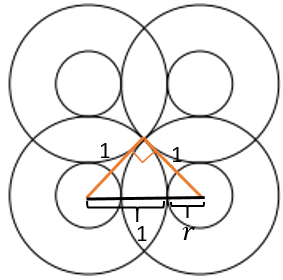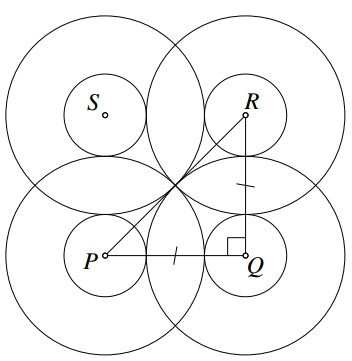Overlapping Annuli
Just from the diagram, can you work out the radius of the smaller circles?
Problem
The diagram shows eight circles of two different sizes.
Image
The circles are arranged in concentric pairs so that the centres form a square.
Each larger circle touches one other larger circle and two smaller circles.
The larger circles have radius 1.
What is the radius of each smaller circle?
This problem is taken from the UKMT Mathematical Challenges.
Student Solutions
Considering a triangle with rigth angle at the central intersection
Consider the following diagram, where the bottom two vertices of the triangle are at the centres of the circles. The angle at the centre is $90^\text{o}$ because the diagram is symmetrical, so $4$ triangles like this could be drawn.

We can use pythagoras on this triangle, whose hypotenuse is $1+r$ and other sides both have length $1$: $$\begin{align}&1^2+1^2=(1+r)^2\\
\Rightarrow&2=(1+r)^2\\
\Rightarrow&\pm\sqrt{2}=1+r\\
\Rightarrow&\pm\sqrt{2}-1=r\end{align}$$
Since $r>0$, must have $r=\sqrt{2} -1$.
Considering a triangle with rigth angle at the centre of one of the annuli
Label the centres of the circles as $P$,$Q$,$R$ and $S$, and call the radius of the smaller circle $r$. Connect up the centres of the circles to form a triangle:

Length $PQ = QR = 1+r$ as they are both the length of the radius of the larger circle plus the radius of the smaller circle. Length $PR$ is equal to two radii of the larger circle (from $P$ to the centre of the image and then to $R$) thus $PR=1+1=2$.
We know that angle $PQR$ is a right angle since it is the corner of a square, so we can use Pythagoras on triangle $PQR$.
We get that $$\begin{align}PQ^2 + QR^2 = PR^2 \Rightarrow &(1+r)^2 + (1+r)^2 = 2^2
\\\Rightarrow&2(1+r)^2 = 4
\\\Rightarrow &(1+r)^2 = 2
\\\Rightarrow &(1+r) = \pm \sqrt{2}
\\\Rightarrow &r = \pm \sqrt{2} -1\end{align}$$
Since $r>0$, must have $r=\sqrt{2} -1$.
Consider the following diagram, where the bottom two vertices of the triangle are at the centres of the circles. The angle at the centre is $90^\text{o}$ because the diagram is symmetrical, so $4$ triangles like this could be drawn.
Image
We can use pythagoras on this triangle, whose hypotenuse is $1+r$ and other sides both have length $1$: $$\begin{align}&1^2+1^2=(1+r)^2\\
\Rightarrow&2=(1+r)^2\\
\Rightarrow&\pm\sqrt{2}=1+r\\
\Rightarrow&\pm\sqrt{2}-1=r\end{align}$$
Since $r>0$, must have $r=\sqrt{2} -1$.
Considering a triangle with rigth angle at the centre of one of the annuli
Label the centres of the circles as $P$,$Q$,$R$ and $S$, and call the radius of the smaller circle $r$. Connect up the centres of the circles to form a triangle:
Image
Length $PQ = QR = 1+r$ as they are both the length of the radius of the larger circle plus the radius of the smaller circle. Length $PR$ is equal to two radii of the larger circle (from $P$ to the centre of the image and then to $R$) thus $PR=1+1=2$.
We know that angle $PQR$ is a right angle since it is the corner of a square, so we can use Pythagoras on triangle $PQR$.
We get that $$\begin{align}PQ^2 + QR^2 = PR^2 \Rightarrow &(1+r)^2 + (1+r)^2 = 2^2
\\\Rightarrow&2(1+r)^2 = 4
\\\Rightarrow &(1+r)^2 = 2
\\\Rightarrow &(1+r) = \pm \sqrt{2}
\\\Rightarrow &r = \pm \sqrt{2} -1\end{align}$$
Since $r>0$, must have $r=\sqrt{2} -1$.
